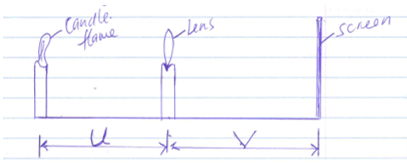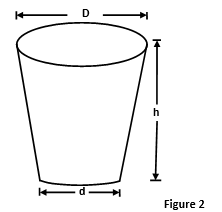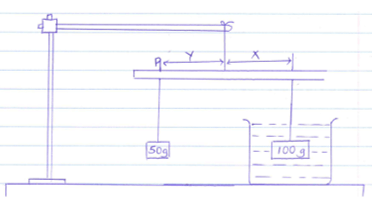INSTRUCTIONS
- Answer ALL the questions in the spaces provided in the question paper.
- You are supposed to spend the first 15 minutes of the 2½ hours allowed for this paper reading the whole paper carefully before commencing your work.
- Marks are given for a clear record of the observations actually made, their suitability, accuracy and the use made of them.
- Candidates are advised to record their observations as soon as they are made.
- Non-programmable silent electronic calculators may be used.
- Candidates should answer the questions in English.

QUESTIONS
Question 1:
Each student will require the following
- 2 new dry cells
- 2 cell holders
- A switch
- An ammeter (0- 1A)
- A voltmeter (0 – 5V)
- 8 connecting wires
- A nichrome wire 1.0m long mounted on a scale labeled X
- A micrometer screw gauge (can be shared)
Proceed as follows
- Connect the circuit as shown in the figure below

- Measure the e.m.f, E (across the cells) before closing the switch
E= ………………………………….. (1mark) - Adjust the length L of the wire 0.2 m, close the switch S and read the value of current and record the table below
Length L(m)
0.2
0.3
0.4
0.5
0.6
0.7
Current I (A)
(A-1)
- Repeat the procedure in (c) above for the value of lengths given (4 marks)
- Calculate the values of 1/I and record in table above
- On the grid provided, plot a graph of 1/I (y axis) against L (5marks)

- Determine the gradient of the graph 3 (marks)
-
- Measure the diameter of the wire in three points used
d1 =
d2=
d3 =
Average d= (1mark) - Determine the cross section area, A, of the wire (2marks)
From the equation
1/I = kL/AE + Q/E
determine,- the value of k (2 marks)
- The value of Q (1mark)
- Measure the diameter of the wire in three points used
QUESTION 2.
PART A
You are provided with the following
- A candle
- A lens and a lens holder
- A screen
- A metre rule
- Set up the apparatus as shown in figure below (ensure that the candle flame and the lens are approximately the same height above the bench)

- Set the position of the lens so that the 40cm from the candle (U=40). Adjust the position of the screen until a sharp image of the candle flame is obtained. Measure the distance, V between the lens and the screen. Record the value of V1
V1 = ………… cm (1 mark) - Repeat the procedures in (b) above for other values of U in the table b below. (3 marks)
Table b)
U(cm)
45
50
55
V(cm)
Magnification (m)
- Given that f = v/ m+1, where f is the focal length of the lens, use the results in table above to determine the average values of f. (4 marks)
- Set up the apparatus as shown in figure below (ensure that the candle flame and the lens are approximately the same height above the bench)
PART B.
You are provided with the following:
- rubber bung.
- vernier calipers.
- beam balance.
Proceed as follows: - Using a vernier caliper, measure the lengths D, d, and h as shown in figure 2.

D = ....................................................... m (1 mark)
d = ........................................................ m (1 mark)
h = ........................................................ m (1 mark) -
- Measure the mass, M of the rubber bung using the beam balance.
M = ....................................................... kg (1 mark) - Given thatQ=d+D/ 4, determine the value of Q. (1 mark)
- Determine the value of r given that πrQ2= M/d (2 marks)
- Measure the mass, M of the rubber bung using the beam balance.
PART C
You are provided with the following
- a metre rule
- a retort stand, one boss, one clamp
- One 500ml beaker ¾ full of water
- One 100g mass
- One 50g mass
- 3 pieces of thread approximately 30cm long
Procedure
- Balance the metre rule horizontally by suspending it from the stand and clamp with one of the threads.
Record the balance point G
G = __________________ cm (1 mark) - suspend the 100g mass from the metre rule at a point such that x = 5cm from point G, with the 100g mass completely immersed in water in the beaker hang the 50g mass from the metre rule.
Note the point of suspension (p) of the mass
P =______________ (1mark)
- Calculate the apparent weight of the 100 g mass in water. (3 marks)
- Find the upthrust of 100g mass in water. (1 mark)

CONFIDENTIAL
INSTRUCTIONS TO SCHOOLS
- The information contained in this paper is to enable the head of the school and the teacher in charge of Physics to make adequate preparations for this year’s physics practical mock examination. NO ONE ELSE should have access to this paper or acquire knowledge of its contents. Great care must be taken to ensure that the information herein does not reach the candidates either directly or indirectly. Physics teachers SHOULD NOT perform any of the experiments in the same room as the candidates or make the results of the experiments available to the candidates or give any other information related to the experiments. Doing so will constitute an examination irregularity which is punishable.
- The apparatus required by each candidate for the Physics practical examination are set out on page 2 of this paper. It is expected that ordinary apparatus of a Physics laboratory will be available
- The Physics teacher should note that it is his/her responsibility to ensure that each apparatus acquired for this examination agrees with the specification on page 2 of this paper
- Teachers are reminded that electronic calculators may be allowed in this examination room.
- The question paper will not be opened in advance
NB:- ANY USE OF APPARATUS OTHER THAN THE ONES SPECIFIED MAY LEAD TO CANDIDATES BEING PENALIZED
Each student will require the following :-
- 2 new dry cells (size D)
- 2 cell holders
- A switch
- An ammeter (0- 1A)
- . A voltmeter (0 – 5V)
- 8 connecting wires; 4 with crocodile clips
- A nichrome wire 1.0m long mounted on a scale labeled X ( diameter 0.32 mm)
- A micrometer screw gauge (can be shared)
- A candle
- A lens (f = 20 cm) and a lens holder
- A screen
- A metre rule
- Rubber bung (hard). Height h= 2.8cm, wider diameter D= 2.5cm, narrower diameter d= 2.0 cm
- Vernier calipers (shared).
- Electronic beam balance (shared).(which records to 1 d.p.)
- a retort stand, one boss, one clamp
- One 500ml beaker ¾ full of water
- One 100g mass
- One 50g mass
- 3 pieces of thread approximately 30cm long

MARKING SCHEME
Question 1:
Each student will require the following
- 2 new dry cells
- 2 cell holders
- A switch
- An ammeter (0- 1A)
- A voltmeter (0 – 5V)
- 8 connecting wires
- A nichrome wire 1.0m long mounted on a scale labeled X
- A micrometer screw gauge (can be shared)
Proceed as follows
- Connect the circuit as shown in the figure below

- Measure the e.m.f, E (across the cells) before closing the switch
E= ……3.1V ± 0.1V…………………………….. (1mark) - Adjust the length L of the wire 0.2 m, close the switch S and read the value of current and record the table below
±0.05ALength L(m)
0.2
0.3
0.4
0.5
0.6
0.7
Current I (A)
0.50 0.38 0.34 0.30 0.26 0.22 (A-1)
2.000 2.632 2.941 3.333 3.846 4.545
3dp - Repeat the procedure in (c) above for the value of lengths given (4 marks)
- Calculate the values of 1/I and record in table above
- On the grid provided, plot a graph of 1/I (y axis) against L (5marks)

- Determine the gradient of the graph 3 (marks)
gradient =3.80-2.00/ 0.6-0.2
=1.8/0.4
=4.5 A-1m-1 -
- Measure the diameter of the wire in three points used
d1 = 0.32mm
d2= 0.31mm
d3 = 0.32mm
Average d=
0.32+0.31+0.32/ 3
=0.3167mm
(1mark) - Determine the cross section area, A, of the wire (2marks)
crosssection area =πr2
22/7×(0.15835/ 1000)2
=7.881×10-8m2
From the equation
1/I = kL/AE + Q/E
determine,- the value of k (2 marks)

K/ AE =M
K =MAE
=4.5×7.881×10-8×3.1
K =1.0994×10-6Ωm - The value of Q (1mark)
Q/ E =C
C =1.15A-1
E =3.1V
Q =C×E
=1.15×3.1
=3.565Ω
- the value of k (2 marks)
- Measure the diameter of the wire in three points used
QUESTION 2.
PART A
You are provided with the following
- A candle
- A lens and a lens holder
- A screen
- A metre rule
- Set up the apparatus as shown in figure below (ensure that the candle flame and the lens are approximately the same height above the bench)
- Set the position of the lens so that the 40cm from the candle (U=40). Adjust the position of the screen until a sharp image of the candle flame is obtained. Measure the distance, V between the lens and the screen. Record the value of V1
V1 = ……40.0 ±2…… cm (1 mark) - Repeat the procedures in (b) above for other values of U in the table b below. (3 marks)
Table b)
U(cm)
45
50
55
V(cm) ± 2.0 cm
38.0 35.0 33.0 Magnification (m)
0.8444 0.7000 0.6000 - Given that f = v/ m+1, where f is the focal length of the lens, use the results in table above to determine the average values of f. (4 marks)
f1 = 38.0/ (0.8444+1) =20.60cm
f2 = 35.0/(0.7000+1) =20.59cm
f3= 33.0/ (0.6000+1) =20.63cm
fav = f1+f2+f3/ 3 = 20.60+20.59+20.63/ 2
=20.61cm
PART B.
You are provided with the following:
- rubber bung.
- vernier calipers.
- beam balance.
Proceed as follows: - Using a vernier caliper, measure the lengths D, d, and h as shown in figure 2.
D = 2.53/ 100 =0.0253 m 2.33-2.73(1 mark) all ans ±2
d = 2.00/ 100 =0.0200 m 1.80-2.20(1 mark)
h =2.81/ 100 =0.0281 m 2.61-3.01(1 mark) -
- Measure the mass, M of the rubber bung using the beam balance.
M =19.5/ 1000 =0.0195kg ±5g(1 mark) - Given thatQ=d+D/ 4, determine the value of Q. (1 mark)
Q =0.0200+0.0253/ 4
=0.011325m - Determine the value of r given that πrQ2= M/d (2 marks)
r =M/ dπq2
=0.0195/ (0.0200×22/7×0.0113252)
=2418.82 kg/m3
- Measure the mass, M of the rubber bung using the beam balance.
PART C
You are provided with the following
- a metre rule
- a retort stand, one boss, one clamp
- One 500ml beaker ¾ full of water
- One 100g mass
- One 50g mass
- 3 pieces of thread approximately 30cm long
Procedure
- Balance the metre rule horizontally by suspending it from the stand and clamp with one of the threads.
Record the balance point G
G = 50.0 ±0.5 cm (1 mark) - suspend the 100g mass from the metre rule at a point such that x = 5cm from point G, with the 100g mass completely immersed in water in the beaker hang the 50g mass from the metre rule.
Note the point of suspension (p) of the mass
P =58.6 cm ±(1mark)
- Calculate the apparent weight of the 100 g mass in water. (3 marks)
when x=5cm y=8.6cm
w × 5/ 100 =50/ 1000 × 8.6/ 100
w=0.086N - Find the upthrust of 100g mass in water. (1 mark)
∪= real weight - apparent weight
=0.100-0.086
=0.014N
Download Physics Paper 3 Questions and Answers With Confidential - Wahundura Boys Mock Examination 2023.
Tap Here to Download for 50/-
Get on WhatsApp for 50/-
Why download?
- ✔ To read offline at any time.
- ✔ To Print at your convenience
- ✔ Share Easily with Friends / Students
